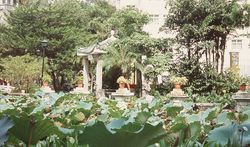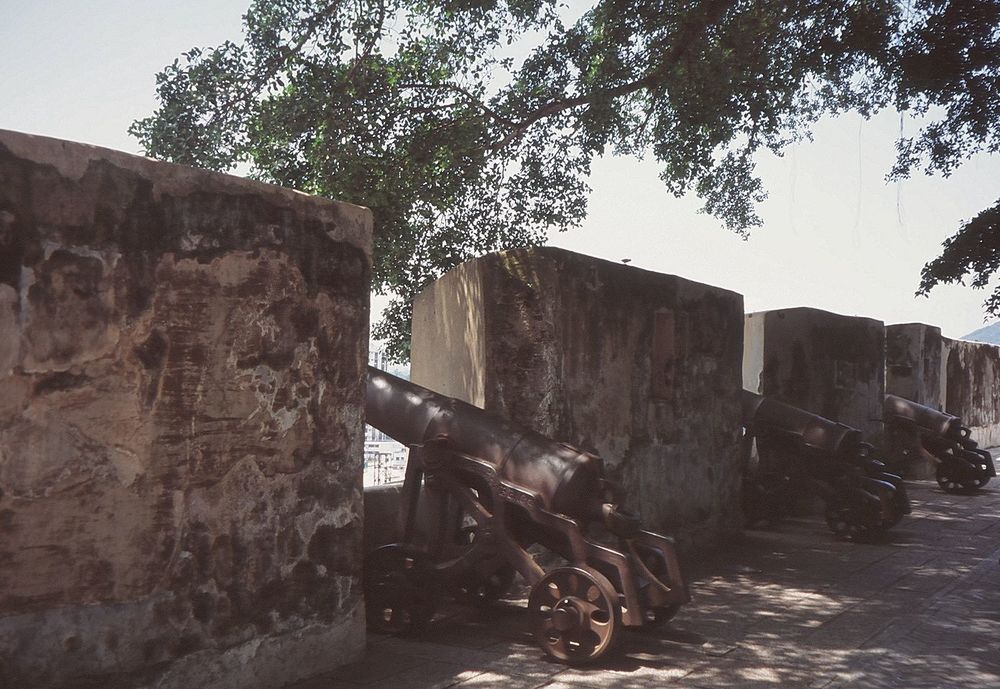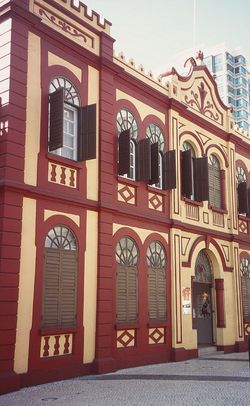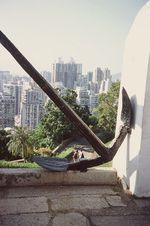Macau's More Mellow Side
words + photos by Jeanine Barone
Macau’s glitzy side with its mega-watt casino resorts is certainly seductive to the majority of visitors who flock to this former Portuguese colony that’s set in the South China Sea. Instead, I was enthralled with Macau’s more serene side:
•  Macau is chock full of green spaces. In leafy Camoes Garden, named for Portugal’s national poet, it’s worth hanging out to observe the local men who, instead of walking their dogs, stroll while carrying their pet song birds in elaborate cages. Also, check out the reflexology path where you’ll get a much-needed foot massage by walking barefoot over the rough pebbled surface.
Macau is chock full of green spaces. In leafy Camoes Garden, named for Portugal’s national poet, it’s worth hanging out to observe the local men who, instead of walking their dogs, stroll while carrying their pet song birds in elaborate cages. Also, check out the reflexology path where you’ll get a much-needed foot massage by walking barefoot over the rough pebbled surface.
• One of the most curious exhibits at the Museum of Macau is the cricket fighting display, complete with tiny cricket coffins and tombstones. (Don’t worry, there are no live crickets here.)
• The upper level of the Museum of Macau opens to a lovely green patio that’s ringed by cannons and the old crenellated walls of this fort that was once a defense against the Dutch. (This is also the site for the annual Macau International Music Festival.) • Ramble down the Rua do Sao Paulo, a pedestrian street where you can sample thin sheets of spicy piglet or wild boar jerky and even check out a medicine shop selling healing and pain relieving oils and other traditional remedies in jars, bottles and bags.
• Ramble down the Rua do Sao Paulo, a pedestrian street where you can sample thin sheets of spicy piglet or wild boar jerky and even check out a medicine shop selling healing and pain relieving oils and other traditional remedies in jars, bottles and bags.
• At the Tap Seac Gallery, a quaint colonial-era façade with brown shutters belays a spare industrial interior where an ever-changing collection of contemporary art is on display in the light-filled internal patio. I was struck by the motion inherent in the bronzes of Korean sculptor Kim Seon-Gu. 
• It’s far more rewarding to walk up the steep path — rather than opting for the cable car — to reach the 17th century fortress, the tiny chapel with mural remains and all atop lush Guia Hill. I took in the panoramic views, then I joined the rest of the local joggers along the .7-mile often shady loop path that rings this hill.
• As an oenophile, I was delighted with the Wine Museum where I sipped a handful of fine Portuguese wines and especially enjoyed the white port and the vinho verde, both from the Duoro Valley. I also spotted the museum’s oldest bottle, a port dating from 1815.
• Edgy art appears in the unlikeliest places, including the historic Leal Senado Building, a mansion with a vine-draped and tiled courtyard, as well as a former dwelling for aged women that now houses the contemporary Albergue Gallery — the small exhibit space brimmed with umbrellas, cups and bags splashed with multi-colored strips of ad slogans. (This is Huang Guang Hui’s take on advertising overkill.)
• One of the most charming locales that harkens to Old World Portugal is the peaceful waterfront esplanade that fronts the Carmel Gardens and the five green and white-trimmed neo-classical mansions of the Taipa Houses Museum on petite Taipa Island. (One of the houses hosts temporary art exhibitions, including the highly sculpted metal jewelry — really wearable art — of Jacques Troalen.) 
• Hiking paths snaking through a green landscape are a short taxi ride from your hotel. My favorite was the Main Coloane Island trail on the eponymous island. The five-mile path circles just below the summit where the white marble statue of the Taoist goddess, A-Ma, towers. Even on a sweltering day, you can escape the sun in the any of the ornate pavilions that punctuate the path.
• If only all libraries were similar to what I found at the Sir Robert Ho Tung Library. Young and old alike read and studied under umbrellas and shade trees on this verdant historic property with its small pools, fountains and ivy-laden arbors.
• Macanese cuisine may very well represent the world’s first fusion food. Menus blend Portuguese sausages and seafood (codfish, prawns, clams, sardines and octopus) with Chinese, African, Malaysian and even Indian ingredients, such as cabbage, bananas, curries, chilies and coconut milk. These are the restaurants I highly recommend for their authentic ambience and culinary delights:
1. O Porto Interior
2. A Lorcha
3. Antica Trattoria da Iza
4. Litoral
5. Restaurante Espaco Lisboa
6. Antonio’s
Jeanine Barone is an independent travel, food, design and architecture writer and consultant who specializes in hidden treasures. She travels the world, many times on bicycle, on foot or on Nordic skis, seeking out experiences and sites that are under the radar. Her work appears in dozens of publications, including National Geographic Travel, Travel + Leisure and Conde Nast Traveler.